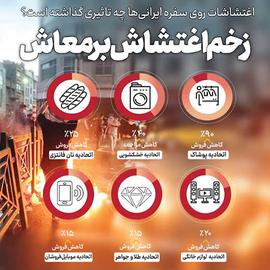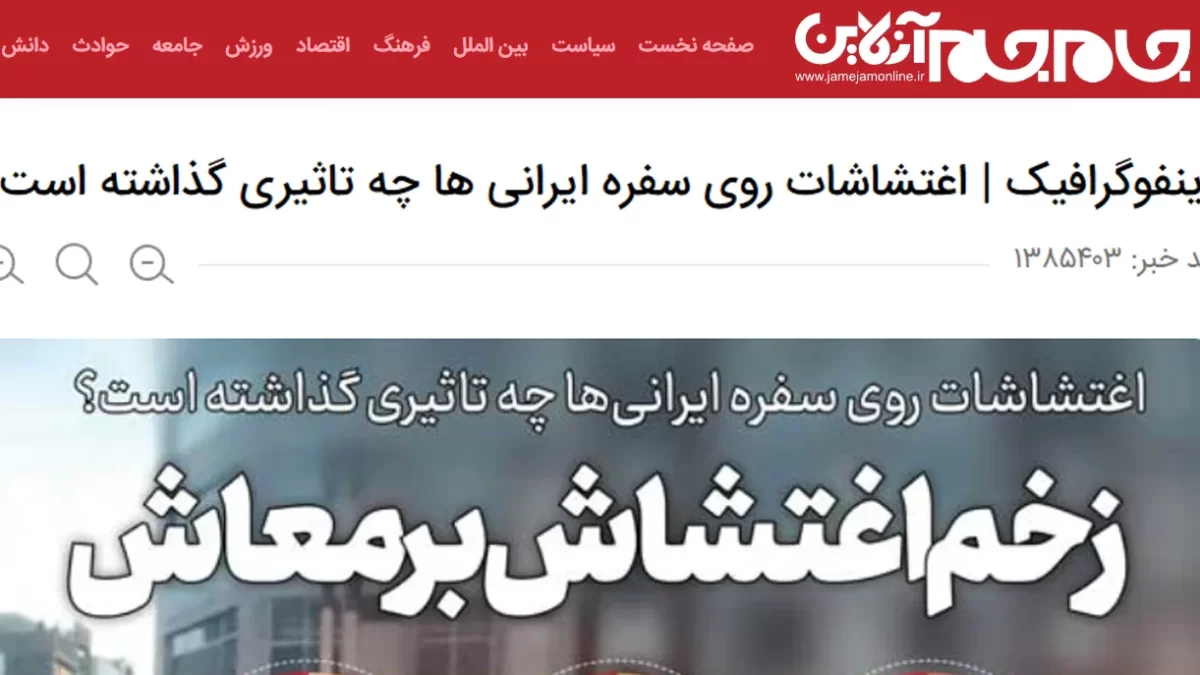
Annotation of Fars News Agency on statements without facts of the leadership
May 7, 2023
Media review; Qassem Soleimani is the headline of newspapers; Money or force?
May 7, 2023The most important and appealing feature of “data journalism” is uncovering hidden truths within data through the use of graphs and visualizations.
Data journalism has gained prominence in the media in recent years because it offers a significant solution for audiences who no longer have the patience or time to read lengthy reports.
By relying on data and combining it with visualization, data journalism simplifies both information consumption for the audience and data analysis for journalists.
In fact, the significance and appeal of data journalism lie in its ability to provide more accurate and tangible validation and fact-checking of events. Since information is conveyed through data publication and can be measured, graphs make their retrieval more precise and easier.
Data journalism has a positive impact on increasing transparency and accountability since it makes performances measurable. Unlike analyzing events, which can be ambiguous and vague, data analysis, being quantifiable, carries greater accuracy. From this perspective, data journalism is a desirable and more engaging model among the styles of journalism for today’s audience.
However, if data journalism is used to deceive the audience, it can have reverse results. In other words, it is possible to lie with numbers and create imaginary graphs, but lying with numbers is more challenging to detect because it is easier for observers and auditors to identify deception.
To illustrate the issue, let’s examine the infographic published by the news outlet “Jamejam” titled “What Impact Did the Disturbances Have on Iranian Tables?” on 10 Aban 1401 (November 1, 2022).
Regardless of the article’s headline, which violates the principles of impartiality, avoiding labeling and judgment in journalism, the data presented in this infographic not only fails to clarify the truth but also deliberately attempts to conceal it.
Do the six presented data points in this infographic represent the full extent of the damage inflicted on Iranian tables? Have all relevant data been included in this infographic, or has there been selective filtering? Has the big data or the primary data that explains the harm to businesses been given proper attention in this infographic?
Can we arrive at a realistic and accurate analysis of the impact of the past 45 days’ events on Iranian tables with these six data points? Has the source of this data been disclosed? Do credible sources confirm the presented data?
In the past month, economic entities have repeatedly stated that the internet shutdown and blocking Instagram have caused the most damage to online businesses.
The secretary of the “Virtual Businesses Union,” on the 10th of Mehr 1401 (October 2, 2022), just 11 days after the internet shutdown, stated in an interview with “Tajarat News,” “The livelihoods of 10 million people are now dependent on the virtual space, but now the internet shutdown has affected the employment and livelihoods of this group, and they don’t even know if the internet will be reconnected and filtering will be resolved. In these circumstances, one million jobs are at risk.”
However, this infographic makes no mention of the impact of the internet shutdown on Iranian tables because Jamejam is not an independent and free media outlet capable of challenging the government by presenting the facts.
Even if we assume that all the presented numbers in this infographic are from credible sources and not fabricated, it is still evident that this infographic selectively chooses some data from a vast dataset with specific objectives. Therefore, this report is neither accurate nor valid.
There is always a meaningful relationship between insecurity and economic stability. Insecurity leads to economic instability and incurs high costs as consequences. Data journalism can illustrate the impacts and destructive effects of insecurity on the economy through data integration, graphs, and clear, vivid, and precise visualization, provided that the journalist is independent, free, professional, and utilizes one of the most significant attractions of data journalism, which is uncovering the hidden truth within the data. However, such expectations cannot be placed on government tribunes that do nothing but propagate and produce disinformation.
Although this infographic may have been designed based on accurate data, since it deliberately hides a large portion of the truth and aims to assist the repressive apparatus, it should be considered an example of disinformation.
Therefore, data journalism, like other styles of journalism, can contribute to uncovering the truth only when it is founded on the principles and ethics of journalism and not framed within political and propaganda objectives. Selective handling of data and purposefully concealing other relevant data, similar to the selective information selection by news narrators, with the difference that uncovering deception in data-driven journalism is easier for observers and quickly undermines the credibility of the media.
مرور رسانهها؛ جام جم و پنهانکاری اطلاعات با دادههای نامعتبر
مهمترین و جذابترین قابلیت «دیتا ژورنالیزم» (روزنامهنگاری دادهمحور)، کشف حقیقت نهفته در دادهها با استفاده از گرافها و خلق تصاویر است.
دیتا ژورنالیزم چند سالی است که جای خود را در رسانهها باز کرده، چراکه برای مخاطبی که دیگر حوصله و وقت خواندن گزارشهای طولانی را ندارد، پاسخ قابل توجهی است.
دیتا ژورنالیزم با تکیه بر دادهها و تلفیق آنها با تصویرسازی، هم دریافت اطلاعات را برای مخاطب و هم تحلیل دادهها را برای روزنامهنگاران سادهتر میکند.
در واقع، اهمیت و جذابیت دیتا ژورنالیزم به این است که درستیسنجی و حقیقتیابی رویدادها را دقیقتر و ملموستر میسازد، چراکه اطلاعات از طریق نشر دادهها منتقل میشوند و قابل اندازهگیری هستند و گرافها دریافت آنها را دقیقتر و آسانتر میسازند.
دیتا ژورنالیزم هم بر افزایش شفافیت و هم پاسخگویی تاثیر مثبتی دارد، چراکه عملکردها را قابل اندازهگیری میکند. برخلاف تحلیل وقایع که میتواند مبهم و با کلی گویی همراه باشد، تحلیل دادهها چون کمی و قابل اندازهگیری است، دقت بیشتری را به همراه دارد. از این حیث، دیتا ژورنالیزم مدلی مطلوب و جذابتر در میان سبکهای روزنامهنگاری برای مخاطب امروزی است.
اما اگر قرار باشد دیتا ژورنالیزم برای گمراه کردن مخاطب استفاده شود، میتواند نتایج معکوس به همراه داشته باشد؛ به عبارت دیگر، با اعداد و ارقام هم میتوان دروغ گفت و گرافهای خیالی کشید ولی دروغگویی با اعداد سختتر است، چون شناسایی دروغ برای ناظران و حسابرسان سادهتر خواهد بود.
برای روشن شدن مساله، به این اینفوگرافیک منتشره توسط پایگاه خبری «جام جم» که با عنوان «اغتشاشات روی سفره ایرانیها چه تاثیری گذاشته است؟» در تاریخ ۱۰ آبان ۱۴۰۱ منتشر شد، دقت کنید:

فارغ از تیتر مطلب که ناقض اصل بیطرفی و پرهیز از برچسبزنی و قضاوت در روزنامهنگاری است، دادههای ارایه شده در این اینفوگرافیک نه تنها حقیقت را روشن نمیکنند بلکه عامدانه میکوشند آن را پنهان کنند.
آیا شش داده ارایه شده در این اینفوگرافیک، کل آسیبی که به سفره ایرانی وارد شده است را نشان میدهد؟ آیا همه دادههای مرتبط در این اینفوگرافیک ارایه شدهاند یا برخورد گزینشی رخ داده است؟ آیا ابر داده یا داده اصلی که چرایی آسیب به کسب و کار است، در این اینفوگرافیک مورد توجه قرار گرفته است؟
آیا با این شش داده میتوان به تحلیل واقعبینانه و دقیقی از تاثیر اتفاقات ۴۵ روز گذشته بر سفره ایرانی رسید؟ آیا منبع این دادهها اعلام شده است؟ آیا منابع معتبر، دادههای ارایه شده را تایید میکنند؟
طی یک ماه گذشته، نهادهای اقتصادی بارها اعلام کردهاند که قطع اینترنت و مسدود کردن شبکه اینستاگرام بیشترین آسیب را به مشاغل آنلاین وارد کرده است.
دبیر «اتحادیه کسبوکارهای فضای مجازی» روز ۱۰ مهر ۱۴۰۱، یعنی تنها ۱۱ روز پس از قطعی اینترنت در گفتوگو با «تجارتنیوز» گفت: «معیشت ۱۰ میلیون نفر اکنون وابسته به فضای مجازی است اما حالا قطع اینترنت، اشتغال و معیشت این گروه را نشانه گرفته است و این گروه حتی نمیدانند اینترنت دوباره وصل و فیلترینگ برطرف میشود یا نه. در این شرایط، یک میلیون شغل در معرض خطر است.»
ولی در این اینفوگرافیک هیچ اشارهای به تاثیر قطعی اینترنت بر سفره ایرانی نمیشود، چراکه جام جم رسانهای مستقل و آزاد نیست که بتواند با ارایه واقعیتها، حکومت را به چالش بکشد.
حتی اگر فرض کنیم تمام اعداد ارایه شده در این اینفوگرافیک منبع معتبر دارند و جعلی نیستند، باز روشن است که در این اینفوگرافیک، تعدادی داده از یک مجموعه بسیار وسیع دادهها با اهداف خاص دستچین شدهاند. بنابراین، این گزارش نه دقیق، نه صحیح و معتبر است.
همیشه بین ناامنی و ثبات اقتصادی رابطه معناداری وجود دارد. با ایجاد یک ناامنی، اقتصاد دچار بیثباتی میشود و از تبعات پرهزینه آن تاثیر میپذیرد. دیتا ژورنالیزم میتواند تبعات و آثار مخرب ناامنی بر اقتصاد را از طریق تلفیق دادهها و گرافها و نیز تصویرسازی روشن، گویا و دقیق روشن سازد؛ مشروط بر این که روزنامهنگار، مستقل، آزاد و حرفهای باشد و از مهمترین جاذبه دیتا ژورنالیزم، یعنی کشف حقیقت نهفته در دادهها استفاده کند. ولی چنین انتظاری از تریبونهای حکومتی که کاری جز پروپاگاندا و تولید دیس اینفورمیشن نمیکنند، نمیتوان داشت.
این اینفوگرافیک هرچند ممکن است براساس دادههای درست طراحی شده باشد ولی از آنجا که بخش بزرگتری از واقعیت را عامدانه پنهان میکند و قصدش کمک به دستگاه سرکوب است را باید مصداق دیس اینفورمیشن دانست.
بنابراین، دیتا ژورنالیزم مثل سایر سبکهای روزنامه نگاری، زمانی میتواند به کشف حقیقت کمک کند که بر مبنای اصول و اخلاق روزنامهنگاری بنیان گذاشته شده و با اهداف سیاسی و تبلیغی فریمبندی نشده باشد. برخورد گزینشی دادهها و پنهان کردن عامدانه سایر دادههای مرتبط، همانند انتخاب گزینشی اطلاعات توسط راویان اخبار است، با این تفاوت که کشف پنهانکاری در روزنامهنگاری دادهمحور برای ناظران سادهتر است و زودتر رسانه را از اعتبار ساقط میکند.




